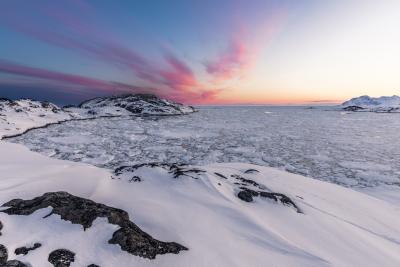Disentangling the Complex Interactions Driving CO2-Related Arctic Sea Ice Loss
Arctic sea ice loss in response to CO2 increases results from a web of complex interactions between the atmosphere, ocean, and sea ice. The tangled atmosphere-ice-ocean interaction makes it difficult to understand or predict the rate of sea ice loss. New research introduces a novel decomposition that isolates the components of sea ice growth and melt changes produced by changes in the ocean’s surface heat input and circulation. Along with a sea ice volume budget, which compares contributions of ocean- and atmosphere-induced sea ice losses to the overall sea ice volume change, the decomposition allows scientists to separate oceanic and atmospheric impacts on Arctic sea ice loss. The study finds that the atmosphere drives most Arctic sea ice volume loss for up to a decade following CO2 increase, while the ocean drives long-term sea ice loss and stability primarily through its circulation changes.
The new ocean-to-ice heat decomposition method separates and quantifies the impact of ocean circulation changes and the resulting ocean heat storage changes on Arctic sea ice loss for the first time. The study reveals that ocean circulation changes are the primary cause of ocean-induced sea ice loss over long time scales. Experiments suggest that impacts of atmosphere-ocean interaction on ocean circulation changes help sustain long-term, seasonal sea ice growth, preventing the complete loss of Arctic sea ice. Understanding sea ice loss is important because the process impacts Earth’s overall energy balance and the rate of global surface temperature increase.
Researchers developed a new decomposition of the ocean heat storage changes that result in sea ice volume change. It enabled them to disentangle components of the atmosphere-ice-ocean interaction that drives Arctic sea ice loss under increased CO2. Researchers used tracers added to an ocean model experiment to track components of the changes in sea ice melt and new ice growth over the open sea that are produced by changes in the ocean’s surface heat input and its circulation changes under CO2 increase. Additional experiments revealed the role of the atmosphere-ocean interaction in augmenting the ocean-induced sea ice loss process. Combined with an analysis of the Arctic sea ice volume budget, the decomposition shows that the atmosphere decreases Arctic ice thickness, and thus drives most volume loss within a decade of CO2 quadrupling. Ocean circulation changes drive long-term Arctic sea ice loss by decreasing frazil ice growth, and therefore the seasonal reappearance of sea ice. The interaction of ocean circulation changes with the atmosphere prevents the complete loss of Arctic sea ice in the long term, sustaining seasonal ice in the Arctic.

